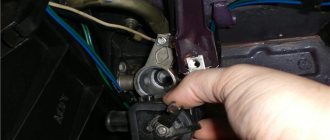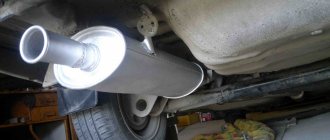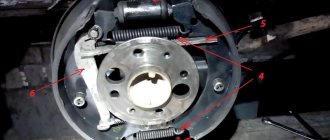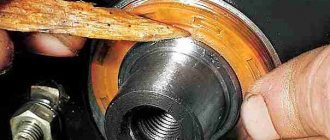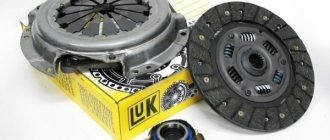Stove tap device
Externally, the faucet of the VAZ 21099 stove from the interior looks like this:
The arrow points to the valve control lever, which is driven by a sheathed rod (“cable”). The tap on the passenger compartment side is connected by pipes to the heater radiator, on the engine compartment side - to the cooling system.
In the photo above it is in the open state, corresponding to the extreme right position of the knob on the stove control panel (bottom photo).
“Souring” of the damper prevents the valve from opening/closing, while incorrect adjustment of the draft increases the free movement of the lever, as a result of which the damper does not open completely and interferes with coolant circulation.
Replacement procedure
If you have been using the car, be sure to let its power plant cool down - otherwise the coolant will be very hot, and this is dangerous.
- VAZ 2110: replacing the stove valve yourself
The car must be placed on a ramp or pit, since you will need access to its bottom.
Before changing the shut-off valves discussed in this article, set the stove regulator to the extreme right position, that is, to maximum heating. Only in this case will you be able to completely drain the coolant from the radiator.
Where is the heater valve installed on the VAZ 21099?
The part is attached to the front panel with two M6s (10 wrench). In the cabin it is located almost exactly in the center of the car, near the floor. The photo shows a view of the faucet with the instrument panel, heater assembly, console and floor tunnel casing removed:
As you can see, it is installed from inside the cabin and secured with two M6 bolts (or studs); the nuts are screwed onto them from the engine compartment side.
In the engine compartment it is located under the steering rack:
Which one is better to choose?
The quality of the new crane largely determines the duration of its operation and the reliability of the entire system.
In total, there are three types of this unit on the Russian market. This means:
- standard, that is, native, used by the manufacturer;
- ball valve;
- ceramic.
The first one is very inexpensive, but usually lasts a fairly short period of time. For this reason, it is worth choosing it only when the car enthusiast does not have extra money or if he was unable to buy anything else.
The ceramic model is more expensive and quite durable, but its disadvantage is its relatively low throughput. If you live in the southern regions, then feel free to take this option. Otherwise, a ball valve is ideal. This type of locking valve is different:
- great reliability;
- strength;
- good throughput.
However, the latter option may also turn sour over time.
Replacing the faucet of a VAZ 21099 stove with a high panel with your own hands
Before work, drain the antifreeze from the cooling system - in any way convenient for you. If the heater tap is replaced on an injection machine, disconnect the battery. Loosen the clamps and remove the pipes from the tap fittings.
Remove the floor tunnel and console. If the engine is fuel-injected, then disconnect the block from the ECU (“brains”) mounted inside the console. Having removed the pipes from the tap fittings on the interior side, unscrew the nuts securing it located outside and remove the tap along with the seals.
Before installing a new product, check the damper lever linkage adjustment. The rod shell is secured with a special metal clamp:
By changing the position of the shell, ensure that the tap closes and opens completely when moving the lever on the panel.
Before connecting the pipes, apply sealant to the tap fittings - as a preventive measure against antifreeze leaks.
Having completed the repair, proceed to pouring antifreeze. After opening the expansion tank cap, fill to about. Close the lid and start the engine, and when the coolant temperature begins to rise, turn it off. After opening the lid, wait until the level drops and add liquid to the maximum mark.
Sometimes this procedure has to be repeated up to three times. The pressure generated in the cooling system when the tank is closed will gradually “push out” the air pockets.
Why do breakdowns occur?
As noted above, the shut-off valves of the heater are a very vulnerable element of the VAZ-2109. If it fails, then it will not be possible to ignore the breakdown. First of all, on the floor, at the base of the passenger seat in the first row, a puddle forms under the carpet. In addition, leaking antifreeze emits a very characteristic odor, which should also suggest a malfunction of the stove.
Leakage occurs for three main reasons:
- use of low-quality cranes by a domestic automaker;
- oxidation;
- mechanical destruction.
The Volzhsky plant supplies its products with membrane-type locking fittings. This system has one inherent drawback - poor tightness. Even with careful use, such taps break very quickly.
- VAZ 2115 heater valve: replacement, where is it located
The second malfunction occurs due to the fact that the heating system is not used for at least 4-5 months a year. This period is quite enough for the valve casing and moving elements to become covered with sediment. As a result, his insides literally stick together. The owner of the car makes a significant effort to open it, and as a result the unit simply collapses. That is, a third type of breakdown occurs.
Problems with VAZ 2108-99 heaters with a high panel
Almost all owners of these cars note that cars with a high panel have a “colder” stove. Moreover, measures such as replacing and adjusting the heater tap, replacing an aluminum stove radiator with a copper one do not bring the desired result.
The point is a flaw, or, more precisely, a miscalculation in the design of the heater as a whole. For comparison, look at how heaters with low (a) and high (b) panels are arranged:
The heater control damper 8, working “paired” with a tap, on a stove with a high “torpedo”, is structurally designed to create less resistance to air movement, which contributes to better “purging” of the radiator.
But in reality, it constantly warps, as a result, cold air is not cut off (when the tap is open), but gets into the cabin in addition to the radiator. It’s practically impossible to eliminate this on your own, so some owners change the stove body by installing the “old” version.
Selecting a heating tap and cost of the part
A driver faced with a leaking heating tap will inevitably be faced with the question: which tap to buy as a replacement? The question is not as simple as it might seem at first glance. Because there are three types of heating taps, which differ not only in cost, but also in design. Let's list them:
- faucet with membrane. This is exactly the crane that the manufacturer installed on the “nines” that came off the production line. Cost - from 400 rubles. This is the cheapest faucet that can be found on the market today. However, the low price should not deceive the car owner: the reliability of membrane taps leaves much to be desired. And you can purchase them only in one case: when you couldn’t find anything else;
- ball valve As the name suggests, the locking element in this device is a massive ball, which is much more reliable than a standard membrane. However, the above ball is made of steel. And therefore susceptible to corrosion. Therefore, a car owner who decides to open the tap with the onset of cold weather may be in for a very unpleasant surprise. The cost of such a crane starts from 550 rubles;
- ceramic faucet. The most reliable and at the same time the most expensive option. Corrosion is not a problem for such devices: their body is made of plastic, and the antifreeze is locked by two tightly pressed ceramic plates. The cost of a ceramic faucet starts from 700 rubles, and if the car owner is not short of money, then ceramics should be purchased.
Some car enthusiasts install plumbing taps under the hoods of their cars.
What to do in case of depressurization
If there is a flood in the cabin, then first of all you need to move the crane control handle to the extreme left position. This will save you from scalding, engine overheating and the need to buy another bucket of antifreeze. If the valve is closed, but coolant flows out from under the torpedo, it means that the supply pipes, hoses, or the valve itself have burst. In this case, you need to urgently stop, turn off the engine and either take the car to a service center, or get the necessary tools from the trunk and begin repairs.
How is the replacement made?
If the tap does not open and you discover a problem in the summer, then there is no need to rush, but the leak requires prompt elimination - after all, the cooling system is constantly losing antifreeze, and this, in turn, calls into question the normal functioning of the power plant.
You should know that in both older and new 2109 models, the tap is located opposite the front passenger seat, under the panel.
To replace the unit in question you will need the following:
- new tap;
- a set of gaskets (usually it is sold complete with the above unit);
- a can of WD40 or its equivalent;
- wire brush;
- wrenches for 13 and 10 (both socket and ring);
- screwdrivers;
- container for antifreeze;
- new coolant.
Radiator check
In most cases, there is a failure of one part of the VAZ-21099 stove. The check can begin with the radiator of the heating system.
In this case, it is advisable to carry out the check after any of the following manifestations appear in the cabin:
- specific smell;
- steam coming from exhaust vents;
- rapid evaporation of the liquid used for cooling.
In such situations, it is initially recommended to check the radiator, and any actions are best carried out after the engine has been turned off and it has had time to cool down.
If, nevertheless, no problems were found in the radiator, most likely the VAZ-21099 heater valve will need to be replaced. However, additional steps are required before this happens.
First of all, you need to carefully inspect the radiator you are using for potential leaks and the condition of its design.
How to check the radiator before understanding whether the heater valve of a VAZ-21099 car needs to be replaced or not.
- At the very beginning, you need to disconnect and remove the car battery.
- After this, the antifreeze is drained from the cooling system.
- The next stage is the sensor and motor.
- Now you can remove the casing fasteners and carefully disconnect all the wires.
- In addition, you can remove the protective cover.
- The final stage is to disconnect the hoses, slightly tilt the radiator to the side and pull the part out.
- In most cases, replacement of rubber shock absorbers installed on special radiator holders is required.
- After removing the unit, you will need to install tight plugs on the pipes or holes to which they are connected. According to this scheme, air is gradually pumped into the radiator. It is important to note that the air pressure should not exceed 0.2 MPa. Then it is allowed to lower the radiator into a bath of water, remembering that the unit must be completely covered. The appearance of air bubbles indicates a leak in the seal and the need to replace the radiator. If there are no bubbles, the unit is only clogged and requires flushing to clean it.
After the preliminary action, care should be taken to adjust the tap of the VAZ-21099 stove and ensure full heating of the car interior.
Malfunction - characteristic symptoms
The following signs indicate that the faucet is leaking:
- traces of liquid are found on the floor in the cabin;
- A characteristic smell of antifreeze appeared in the car.
Having discovered one of the above symptoms, it is necessary to inspect the failed unit. It is important to understand that if the breakdown is not repaired in a timely manner, then repairs will subsequently cost much more money, and it will most likely not be possible to do it yourself.
How to perform an inspection? You will need to get under the hood on the engine side. It should be noted that leaks can occur in various places in the cooling system, so you will need to inspect the entire system.
It is more convenient to do this with a flashlight. Coolant, in particular, often drips from:
- radiator;
- joints of hoses and pipes.
When it turns out that the faucet is the culprit of the malfunction, the owner needs to start replacing it as soon as possible.
This requirement is even more relevant if it is winter, because without heating in a car it will be very uncomfortable to move and, moreover, dangerous if you have a long trip through a sparsely populated area.

